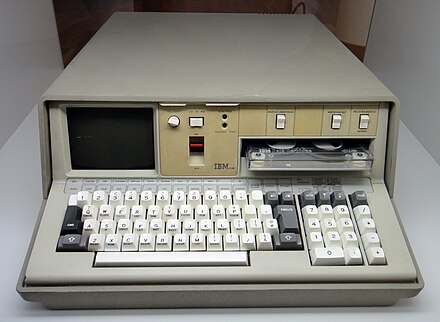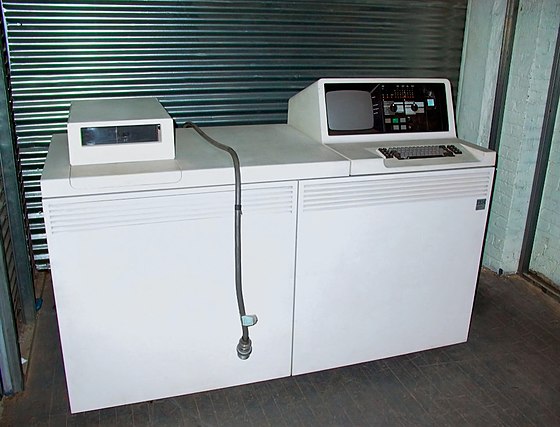IBM notable hardware during the 1970s
1971–1975
In 1971, IBM's System/370 was introduced. It was able to run System/360 programs. The new system included the Model 145, the first general-purpose business computer to use integrated circuits in all memory and logic functions1. As integrated circuits can be made very compact, they had up to several billion transistors and other electronic components in an area equivalent to the size of a fingernail2. Furthermore, the IBM 129 Card Data Recorder was brought into the market. It was capable of punching and veryfying, it used an electronic 80-column card reader and punch and the card could be punched automatically. A switch on the keyboard console provided the ability to toggle between the punch and verify modes. Its primary advantage over other IBM keypunches was that a keystroke error could now be erased by pressing the “Backspace” key3.
IBM also introduced the industry's first flexible magnetic disk in 1971, which came to be known as the “floppy disk”. It made data handling much easier. As a result, it became widely used as a basic storage medium for small systems4. Moving on to 1973, IBM brought about the IBM 3340 disk unit – known as “Winchester”, after IBM's internal project name. Winchester more than doubled the information density on disk surfaces to nearly 1.7 million bits per square inch. It featured a smaller and lighter read and write head that was designed to ride on an air film only 18 millionths of an inch thick. Given these great developments, Winchester technology was adopted by the industry and used for the next two decades5.
Forwarding to 1975, IBM researchers discovered the first polymer to become superconducting and lose nearly all resistance to electric current flow6. Additionally, IBM introduced the IBM 5100 Portable Computer12, a 25kg desktop machine the size of a small suitcase that put computer capabilities at the reach of engineers, analysts, statisticians and other problem-solvers6. It could be transported in an optional carrying case, hence the name “portable”. While it may appear large today, in 1975 it was an amazing technical achievement to package a complete computer with a large amount of ROM and RAM, CRT display and a tape drive into a machine that small.
1976–1979
Moving to 1976, the first IBM 3800 printer was released. The 3800 was the first commercial printer to combine laser technology and electrophotography. The technology sped up the printing of bank statements, premium notices, and other high-volume documents. It has remained a workhorse for billing and accounts receivable departments4.
In 1978, IBM introduced the 3033 multiprocessor complex. It included two processors with a main memory capacity ranging from 4, 194, 304 to 8, 388, 608 characters of information each, in 2, 097, 152 character increments, giving users a choice of 8, 10, 12, 14 or 16 million characters of shared storage. This provided an increased power and capacity for advanced applications such as online business data communication networks and uninterrupted data processing operations7.
Additionally, IBM announced the mid-range IBM System/38 in 1978, a general purpose computer that incorporated new semiconductor technology. It was the only commercial computer with a built-in relational database8. System/38's hardware and programming innovations permitted many functions associated with large computers to be combined into a compact system. The System/38 achieved considerable acceptance in the early 1980s but was ultimately succeeded by the even more popular IBM AS/400 midrange computer family in 19889. Moving to 1979, IBM introduced a hologaphic scanner technology in its supermarket checkout station. It was one of the first major commercial uses of holography as “wraparound” light rays read the UPC (Universal Product Code) stripes on merchandise. IBM's ssupport of the UPC concept helped lead to its widespread acceptance by retail and other industries around the world10.
As a final note, IBM introduced the first disk drive to feature thin-film inductive heads and a run-length-limited (RLL) coding scheme, the IBM 337014. Thin-film heads led to a new era in the design of higher-performance recording heads and the "2-7" RLL code permitted higher performance while also reducing errors. Overall, this led to higher performance recording heads at reduced cost and established IBM's leadership in “areal density”, a term referring to storing the most amount of data in the least amount space10.
External Links
- [Visited on 06/11/2014] IBM Highlights, 1970-1984
- [Visited on 06/11/2014] Wikipedia: Integrated Circuit
- [Visited on 06/11/2014] Wikipedia: IBM 129 Card Data Recorder
- [Visited on 06/11/2014] Wikipedia: History of IBM
- [Visited on 06/11/2014] IBM Archives: 1973
- [Visited on 06/11/2014] IBM Archives: 1975
- [Visited on 06/11/2014] IBM 3033 Multiprocessor
- [Visited on 06/11/2014] IBM Archives: 1978
- [Visited on 06/11/2014] IBM System/38
- [Visited on 06/11/2014] IBM Archives: 1979
- [Visited on 06/11/2014] Chronological History of IBM
- [Visited on 06/11/2014] Wikipedia: IBM 5100
- [Visited on 06/11/2014] IBM Exhibits
- [Visited on 06/11/2014] IBM Archives: IBM 3370 direct access storage device
- [Visited on 06/11/2014] Wikimedia: Picture of IBM 129 Card Data Recorder
- [Visited on 06/11/2014] Wikimedia: Picture of "Floppy Disk"
- [Visited on 06/11/2014] Wikimedia: Picture of IBM 5100
- [Visited on 06/11/2014] Image courtesy of Computer History Museum.
- [Visited on 06/11/2014] Wikimedia: Picture of System 38




